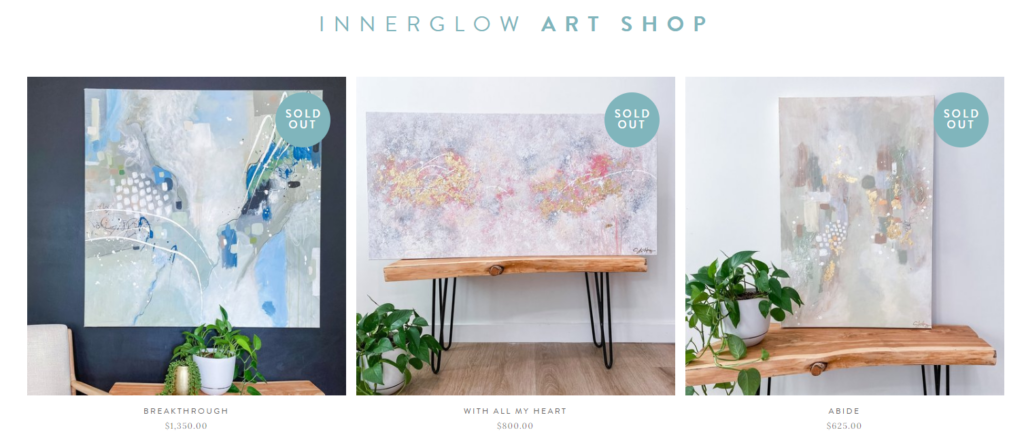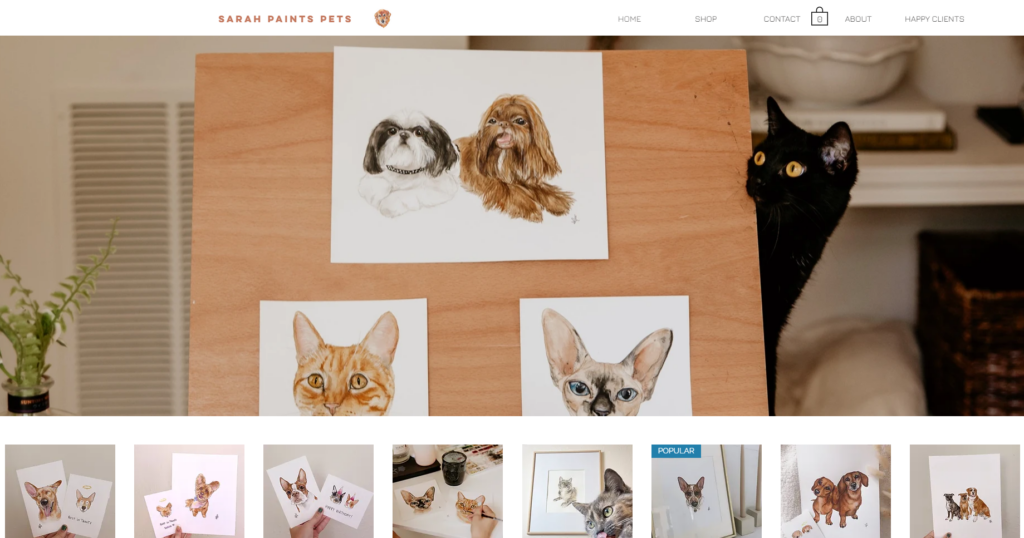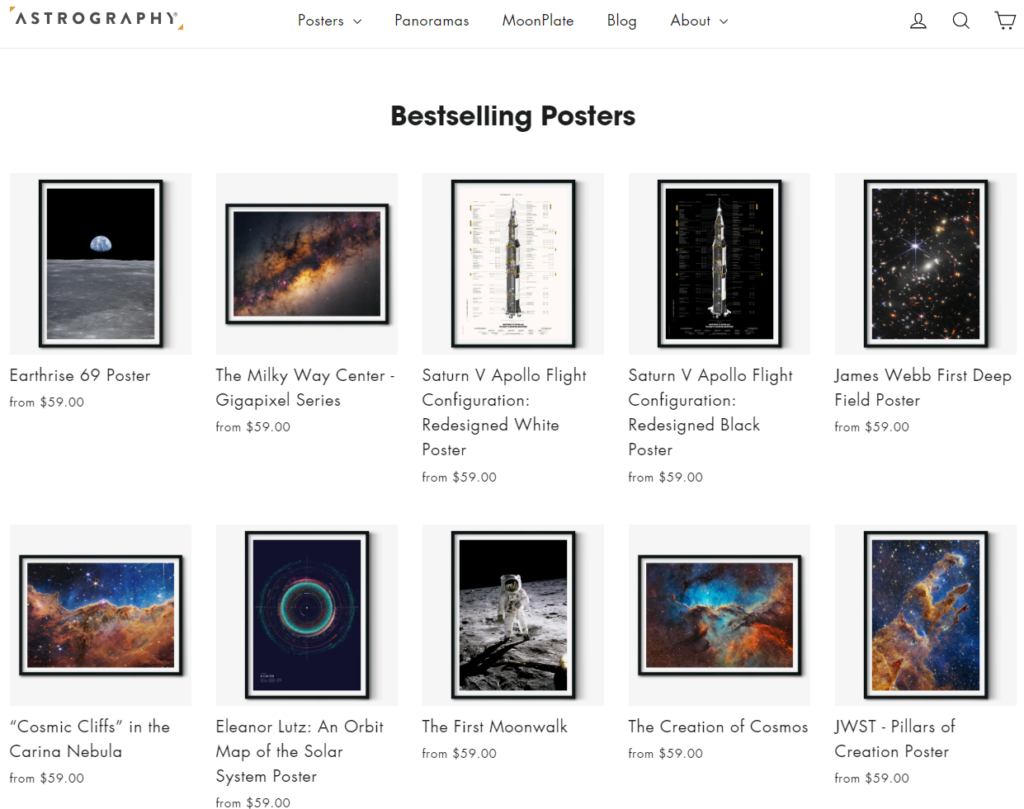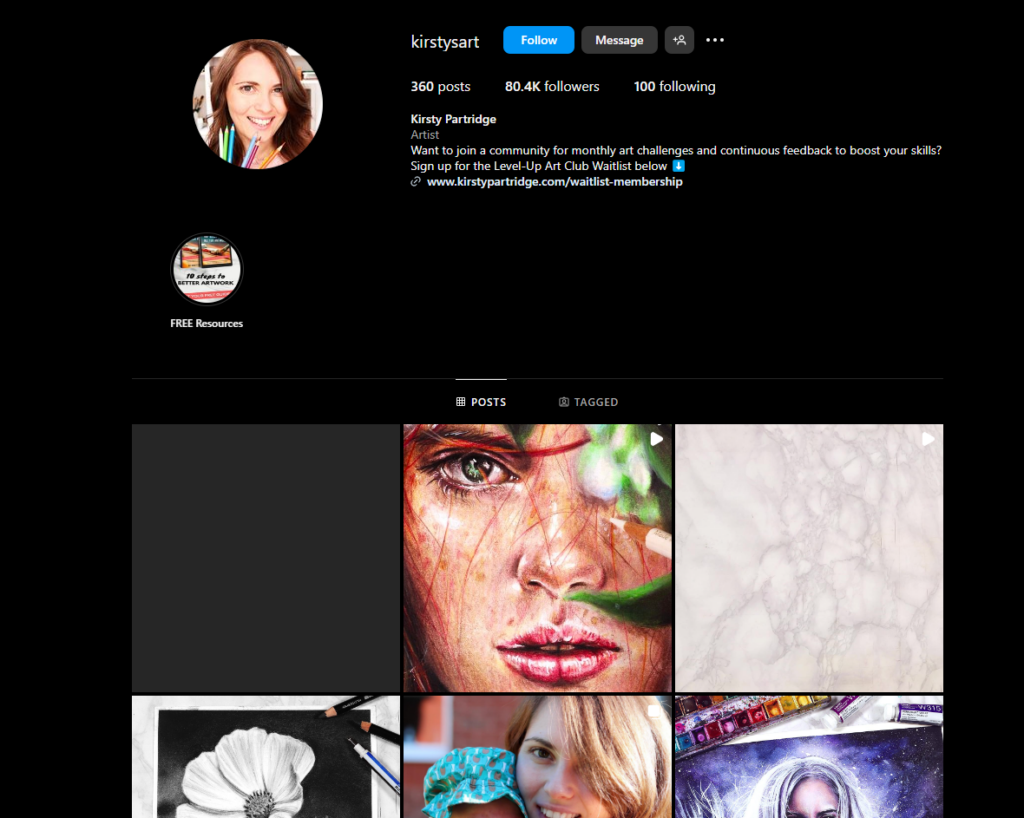Who says you need a fancy gallery to make a living as an artist?
Tech-savvy creatives like Banksy and Shepard Fairey have revolutionized the way art is sold.
With an online store, you take charge, connecting directly with customers who truly appreciate your unique vision.pen_spark
How to Build an E-Commerce Website for Artists to Sell Art Online

Artists have embraced the internet as a powerful tool to showcase and sell their artwork to a global audience.
Building an eCommerce website for artists is an essential step for those looking to take control of their online presence and sales.
With the right ecommerce platform, artists can create a stunning online gallery, manage sales and shipments, and even promote their art to potential buyers worldwide.
This ultimate guide will cover everything you need to know about building an ecommerce website for artists, from choosing the right platform to effective marketing strategies.
So, whether you’re a painter, photographer, sculptor, or digital artist, read on to discover how to showcase and sell your art online successfully.
Choosing the Right E-Commerce Platform for Your Artist Website
When it comes to selecting an e-commerce platform to sell art online, artists have a range of options to choose from.
Each platform has its own unique features, benefits, and pricing plans, so it’s essential to pick the one that best suits your needs as an artist.
Here are some of the best e-commerce platforms for artists to consider:
a). Shopify
Shopify is a popular choice for artists due to its user-friendly interface and powerful e-commerce features.
It offers a wide range of templates, including those specifically designed for artists, making it easy to build a stunning online gallery.
Shopify also provides robust shipping and inventory management tools, as well as advanced analytics to track your online sales and performance.
b). Squarespace
Squarespace is known for its sleek and modern templates, which are ideal for artists who want to showcase their artwork in a minimalist and elegant setting.
While it may not have as many e-commerce features as Shopify, Squarespace offers an incredibly easy-to-use platform for building your artist website.
It also provides strong marketing tools, such as email campaigns and SEO optimization, to help you reach a wider audience.
c). WordPress
WordPress is a highly customizable and flexible platform that offers artists almost unlimited control over the design and functionality of their website.
While it may take a bit more time and technical knowledge to set up, WordPress has numerous e-commerce plugins (such as WooCommerce) that can transform your site into a powerful online store.
This option is excellent for artists who want complete ownership and control over their website and online sales.
d). Saatchi Art
Saatchi Art is a leading online art gallery and marketplace specifically designed for artists to sell their work.
While it functions more like an online art gallery than a traditional e-commerce platform, Saatchi Art provides a global audience of art collectors and buyers.
Artists can create their profiles, upload images of their artwork, and set prices, with Saatchi Art taking a commission on each sale made through the site.
e). Wix
Wix is another user-friendly and intuitive website builder that offers a range of templates specifically designed for artists and creatives.
It provides simple e-commerce functionality, making it easy to add an online store to your artist website.
Wix also has a free plan, making it a great option for artists on a budget who want to test the waters of selling their art online.
Key Features to Look for in an E-Commerce Platform for Artists
When choosing an e-commerce platform to sell your art online, there are several key features you should look out for to ensure a successful and seamless experience for both you and your customers:
#1. Stunning Gallery Display
First and foremost, your e-commerce platform should showcase your artwork in the best possible light.
Look for templates or themes that provide elegant and minimalist gallery displays, allowing your artwork to take center stage.
Ensure the platform supports high-resolution images and has options for zoom or lightbox features so potential buyers can appreciate the detail and beauty of your creations.
#2. Easy Checkout and Payment Processing
A smooth and secure checkout process is essential for converting potential buyers into customers.
Look for platforms that offer a seamless checkout experience, with support for multiple payment methods, including credit cards, PayPal, and even buy-now-pay-later options.
Ensure the platform handles sensitive payment information securely and complies with relevant data protection regulations.
#3. Shipping and Fulfillment
Consider how you plan to ship your artwork to customers and choose a platform that facilitates this process.
Look for features like customizable shipping rates, the ability to offer local pickup or delivery, and even print-on-demand options for artists selling art prints and merchandise.
Integrated shipping labels and tracking can also save you time and streamline the fulfillment process.
#4. Marketing and SEO Tools
Effective marketing is crucial to driving traffic to your artist website and increasing sales.
Look for platforms that offer built-in marketing tools, such as email marketing, social media integration, and SEO optimization.
These features will help you reach a wider audience, promote your artwork, and drive potential buyers to your online gallery.
#5. Analytics and Insights
Understanding your website’s performance and visitor behavior is key to making informed decisions and improving your online art business.
Choose a platform that provides detailed analytics and insights, including sales reports, traffic sources, and customer behavior analytics.
This information will help you identify what’s working well and areas where you can improve to increase sales and engagement.
Designing Your Artist Website: Tips and Best Practices
Once you’ve chosen your e-commerce platform, it’s time to start building your artist website.
Here are some tips and best practices to keep in mind when it comes to website design, ensuring your artwork shines and potential buyers have a seamless and enjoyable experience:
1). Keep it Simple
When it comes to website design, less is often more.
Choose a clean and minimalist template that doesn’t overwhelm visitors with cluttered layouts or flashy design elements that distract from your artwork.
A simple and elegant design will ensure your artwork takes center stage and provides a pleasant viewing experience for your audience.
2). Showcase Your Art Effectively
Treat your website like a digital gallery and curate your artwork thoughtfully.
Display high-quality, well-lit images of your artwork, and consider offering zoom or lightbox features so visitors can appreciate the finer details.
Provide clear and concise descriptions for each piece, including dimensions, medium, and any relevant backstory or inspiration behind the work.
3). Provide Clear Calls to Action
Guide your visitors towards making a purchase by incorporating clear calls to action (CTAs) throughout your website.
Use buttons or links with actionable text, such as “Shop Now” or “Add to Cart,” to encourage potential buyers to take the next step.
Ensure your CTAs stand out visually and are easy to find on each page.
4). Make it Mobile-Friendly
With an increasing number of people browsing and shopping on their mobile devices, it’s crucial that your artist website is optimized for mobile.
Ensure your chosen platform offers responsive templates that automatically adjust to different screen sizes, providing a seamless browsing and shopping experience for mobile users.
Test your website on various devices to ensure it looks and functions perfectly, making it easy for customers to view and purchase your art on the go.).
5). Engage with Email Marketing
Build an email list and engage with your audience through email marketing campaigns.
Offer a newsletter sign-up form on your website to collect email addresses from interested visitors.
Then, use email marketing to promote new artwork, announce sales or exhibitions, and provide exclusive offers to your subscribers, driving them back to your website to make purchases.
E-Commerce Features to Help You Sell More Art
The right e-commerce platform will provide a range of features designed to help you sell more art and streamline the online sales process.
Here are some key e-commerce features to look for and how they can benefit your art business:
a). Secure Payment Processing
Ensure your e-commerce platform offers secure payment processing to protect your customers’ financial information.
Look for platforms that are PCI DSS compliant and offer encryption and fraud protection.
This will give your customers peace of mind and increase their confidence in making purchases from your online gallery.
b). Abandoned Cart Recovery
Many online shoppers add items to their cart but don’t complete the purchase.
Abandoned cart recovery features allow you to send automated emails to these potential customers, reminding them of their selected items and encouraging them to return and finalize the sale.
This simple feature can help you recapture lost sales and increase your conversion rate.
c). Shipping and Fulfillment Options
Look for platforms that offer flexible shipping options, including flat rates, weight-based rates, and the ability to offer free shipping or local pickup.
Integrated shipping label printing and tracking can save you time and streamline the fulfillment process.
Some platforms even offer print-on-demand services, allowing you to sell art prints and merchandise without the hassle of inventory management.
d). Discounts and Promotions
Special offers and discounts are a great way to attract new customers and reward loyal ones.
Look for platforms that allow you to create coupon codes, offer percentage or fixed-amount discounts, and run promotions like “buy one, get one free.”
You can also use these features to clear out older inventory or generate buzz around a new collection.
e). Email Marketing Integration
Email marketing is a powerful tool for artists, allowing you to stay connected with your audience and promote your artwork directly to their inboxes.
Choose a platform that integrates with email marketing services, enabling you to build email lists, send newsletters, and automate campaigns to drive traffic back to your website and increase sales.
Case Study: Success Stories of Artists Selling Online
To wrap this up, here’s a look at successful case studies of artists making a living selling their art online, along with the strategies they use:
Innerglow Art ($51.6K/year)

This artist focuses on selling digital and printable artworks on Etsy.
Her key to success lies in niche selection (spiritual and celestial art) and understanding her target audience’s needs.
She leverages her social media presence for additional promotion.
Sarah Paints Pets ($42K/year)

Specializing in custom pet portraits, Sarah found success by mastering a highly in-demand artistic niche.
She actively interacts with potential customers on social media, nurturing leads, and generating excitement and demand for her work.
Astrography ($1.08M/year)

This success story speaks to the power of scalable products. Astrography sells personalized star maps, a concept that can be easily customized and automated.
They’ve built a streamlined digital product that requires minimal time investment per sale.
Kirsty Partridge Art ($36.7K/year)

Specializing in colorful abstract art, Kirsty’s success comes from building a strong email marketing list.
She consistently nurtures her audience with offers, tutorials, and behind-the-scenes peeks.
Key Strategies Used By These Artists
- Niche Specialisation: Finding a specific, passionate audience makes your work resonate with potential buyers more strongly.
- Digital & Scalable Products: Offering digital prints, printables, or products that can be easily automated allows you to reach a wider audience with less time investment.
- Strong Online Presence: Building a presence on platforms like Etsy, your own website, and social media is essential for visibility and sales.
- Excellent Customer Service: Providing timely communication, customized experiences, and going the extra mile builds positive customer relationships leading to positive reviews and returning customers.
- Email Marketing: Growing an email list is a powerful strategy to directly engage with an interested audience and nurture them towards sales.
Platforms to Consider for Selling Your Art
- Etsy: An established marketplace designed for handcrafted and unique items.
- Your Own Website: Gives you ultimate control over branding and customer experience. Platforms like Shopify and Squarespace make set-up easy.
- Society6: A print-on-demand platform where you upload your art and they handle product creation and shipping.
- Instagram and Facebook: Great for showcasing your work, engaging with an audience, and potentially driving them to your store.
Additional Tips
- High-quality photography: Showcase your artwork with excellent images.
- Compelling product descriptions: Describe your art in a way that evokes emotion and tells a story.
- Pricing strategy: Research market prices and value your work fairly.
- Collaboration: Partnering with other artists, influencers, or businesses can expose your work to new audiences.
Success in selling art online takes time, consistent effort, and a willingness to adapt based on customer feedback.
Don’t be discouraged; focus on creating fantastic works of art and promoting them strategically!
Frequently Asked Questions About Building an E-Commerce Website for Artists
Is it worth it for artists to sell their art online?
Absolutely! Building an ecommerce website for artists is an incredibly effective way to reach a global audience and increase your sales potential. Online art sales are on the rise, and having a dedicated online gallery allows you to showcase your artwork to art lovers worldwide, 24/7. It also gives you more control over how your art is presented and sold, cutting out the middleman and potentially increasing your profit margins.
How do I get my artwork noticed online?
Driving traffic to your artist website and getting your artwork noticed takes a combination of effective marketing strategies. This includes optimizing your website for SEO, utilizing social media platforms to promote your art, and building an email list to engage directly with potential buyers. Consistently creating and sharing new artwork, as well as providing engaging content, will also help attract and retain an audience interested in what you have to offer.
Are there free websites for artists to sell their work?
Yes, there are free website building platforms available for artists, such as Wix, which offers a free plan with basic features. While these free options may have limitations in terms of e-commerce functionality and customization, they can be a great way for artists on a budget to get started and test the waters of selling their art online. Even a free website can help you build an online presence and reach a wider audience for your artwork.
How do I price my artwork for an online store?
Pricing your artwork can be a challenging task, especially for artists new to selling online. Researching similar artists in your medium and style can give you a sense of the market rate for your kind of art. Consider the cost of materials, the time and skill involved in creating the piece, and the demand for your artwork. You may also want to offer a range of price points by selling original artwork, limited edition prints, and other merchandise to cater to a wider range of buyers.
What are some tips for successful online art sales?
In addition to choosing the right e-commerce platform and effectively marketing your artwork, there are a few other key tips for successful online art sales. Ensure you provide high-quality images and detailed descriptions of your artwork, build trust with potential buyers through secure payment processing and clear refund policies, and offer a range of shipping options to cater to different needs and budgets. Respond promptly to customer inquiries and provide excellent customer service to encourage repeat business and positive word-of-mouth.
Start Selling Your Art Online Today
Building an ecommerce website for artists is an exciting and rewarding endeavor that can open up a world of opportunities.
With the right e-commerce platform and effective marketing strategies, you can successfully showcase and sell your art to a global audience.
Remember to choose a platform that showcases your artwork beautifully, provides robust e-commerce features, and offers the flexibility and scalability you need as your art business grows.
Whether you’re a painter, photographer, sculptor, or digital artist, the ability to reach art lovers worldwide has never been easier.
So, take control of your artistic destiny, build your online gallery, and start selling your art to the millions of potential buyers eagerly awaiting the chance to discover your unique creations.
Are you ready to take the plunge and build your ecommerce website for artists?
Which platform will you choose?
Let us know in the comments, and feel free to share any tips or success stories from your own experiences selling art online!
Read also:

